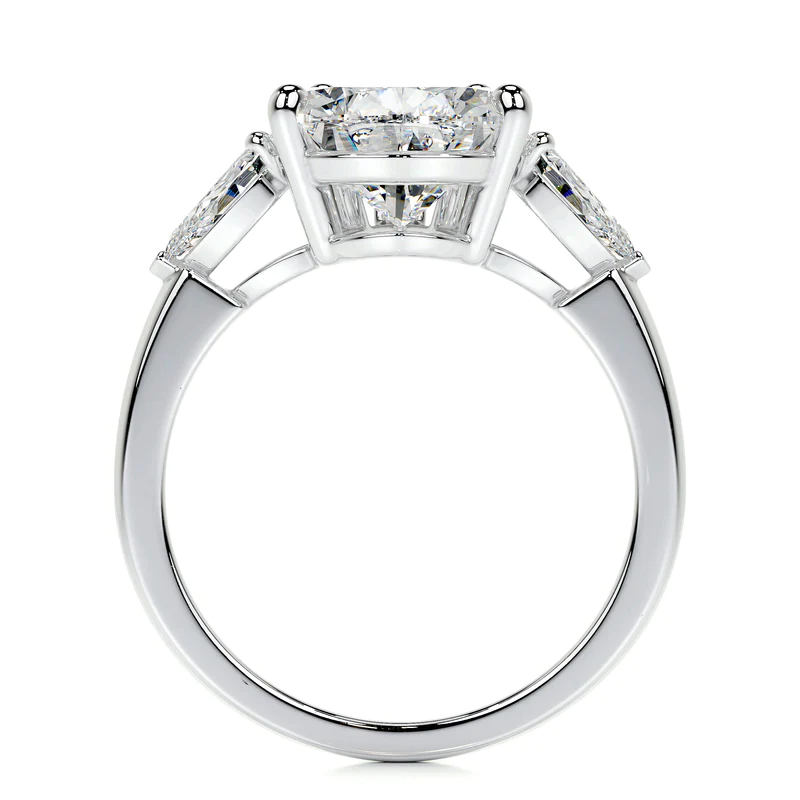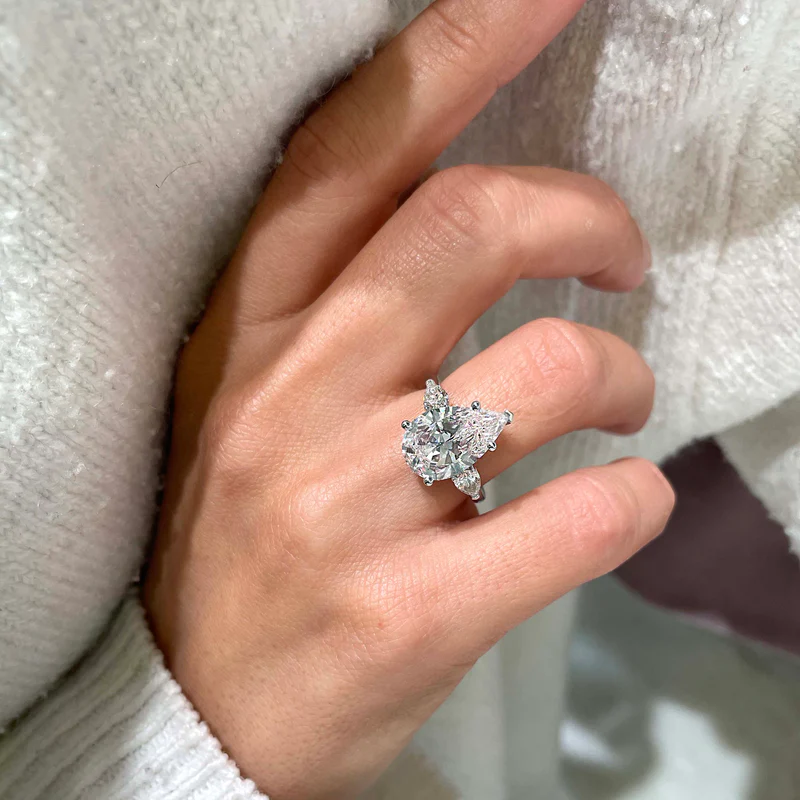A Deeper Dive into the World of Pear Shape Diamond Ring
Diamonds come alive in a mesmerizing variety of shapes, each boasting a distinct personality. Among these, the pear-shaped diamond, with its graceful teardrop form, stands out as a timeless symbol of elegance and romance. This section delves deeper into the history and characteristics of the pear cut, setting the stage for your pear-shaped diamond journey.
A Legacy Steeped in Brilliance: Unveiling the Pear Cut’s History
The pear cut, also known as the pendeloque (French for “pendant”), boasts a rich heritage dating back to the 15th century. Here’s a glimpse into its fascinating evolution:
- Early Beginnings (15th-18th Centuries): The pear shape diamond ring emerged during the early days of diamond cutting when techniques were primarily manual. These early pear diamonds showcased a charming individuality, often with variations in symmetry and brilliance.
- The Rise of Refinement (19th-Early 20th Centuries): As diamond cutting techniques evolved, the pear cut became more refined. The invention of the scarf, a polishing wheel, by Lodewyk van Berquem in the 15th century is believed to have played a significant role in this advancement.
- Modern Marvels (20th Century – Present): The 20th century witnessed the development of even more sophisticated cutting tools and techniques. Today, skilled artisans and advanced technology collaborate to create stunning pear-shaped diamonds with exceptional brilliance, symmetry, and fire.
Beyond the Teardrop: The Allure of the Pear Cut
The pear-shaped diamond captivates hearts with its unique blend of beauty and brilliance:
- A Touch of Romance: The teardrop silhouette evokes a sense of elegance and sentimentality, making it a cherished choice for engagement rings and anniversary bands.
- Flattering Finesse: The pointed end of the pear can create an illusion of a longer, slimmer finger, adding a touch of grace to the wearer’s hand.
- Versatility Unbound: Pear-shaped diamonds transcend limitations, adapting to various design styles. From classic solitaires to vintage-inspired halos and modern geometric settings, they seamlessly complement a wide range of aesthetics.
- A Symphony of Light: When expertly cut, a pear diamond interacts with light in a remarkable way. The facets work together to create a captivating play of fire and sparkle, known as brilliance, that dances within the stone.
Understanding these characteristics empowers you to appreciate the magic of the pear-shaped diamond and embark on your journey to find the perfect one that reflects your unique taste and story.
A Timeless Legacy: Unveiling the History of the Pear Shape Diamond Ring

The pear shape diamond ring, with its graceful teardrop silhouette, boasts a history as rich and captivating as its sparkle. Let’s delve deeper into its fascinating journey:
Early Origins (14th-15th Centuries): The pear cut, also known as the “pendeloque” (meaning “pendant” in French), emerged in the Flemish region of Europe (modern-day Belgium) around the 14th and 15th centuries. This period coincided with the invention of the diamond polishing wheel by Lodewyk van Bercken, a pivotal innovation that revolutionized diamond cutting.
Hand-Cut Elegance: Unlike the precise faceting techniques of today, early pear-shaped diamonds were meticulously crafted by hand. This resulted in variations in shape and brilliance. Some might have had a more rounded body or a slightly asymmetrical cut, adding to their unique charm.
Evolution of the Cut (16th-18th Centuries): As diamond cutting techniques continued to develop throughout the 16th and 18th centuries, the pear shape began to evolve towards a more standardized form. Symmetry and faceting became more precise, allowing for better light reflection and enhanced brilliance.
Symbol of Status and Romance: The pear-shaped diamond quickly rose in popularity among European nobility. Its elegant form was often seen adorning pendants, earrings, and brooches, symbolizing wealth, status, and enduring love. The pointed end was believed to resemble a teardrop or Cupid’s arrow, further solidifying its association with romance.
The Modern Era (19th Century – Present): The 19th century witnessed a surge in the popularity of pear-shaped diamonds in engagement rings. This trend continued into the 20th and 21st centuries, with advancements in diamond cutting technology allowing for even more precise faceting and exceptional fire and brilliance. Today, the pear-shaped diamond remains a sought-after choice for those seeking a unique and romantic engagement ring or a statement piece of jewelry.
The pear-shaped diamond’s journey through history is a testament to its timeless beauty and enduring appeal. From its early hand-crafted elegance to the modern era’s precise brilliance, this captivating diamond cut continues to capture hearts with its unique form and symbolic significance.
Delving Deeper into the Allure of the Pear-Shape Diamond Ring:

The pear-shaped diamond’s captivating beauty goes beyond its simple teardrop form. Let’s explore the specific elements that contribute to its enduring appeal:
Romantic Symbolism: The teardrop shape evokes a sense of eternal love and a single tear of joy. This symbolism resonates deeply with those seeking a meaningful diamond for a special occasion like an engagement or anniversary.
Flattering Silhouette: Illusion is key! The pointed end of the pear diamond, especially when set with the pointed end facing the wearer’s hand, creates a visual elongation of the finger. This can be particularly flattering for those with shorter fingers, making them appear longer and more slender.
Versatility Beyond Compare: Pear-shaped diamonds are incredibly adaptable to various design styles. Here are some popular options:
Classic Elegance: A solitaire setting allows the pear diamond to be the star of the show, showcasing its brilliance and elegant form. This setting is perfect for those who appreciate timeless beauty.
Halo Effect: A halo setting with smaller diamonds surrounding the pear creates a more dramatic and glamorous look. This adds extra sparkle and makes the center stone appear larger, offering a touch of modern luxury.
Three-Stone Symphony: Flanking the pear with two side stones, often round or baguette diamonds, creates a sophisticated and balanced look. This setting is ideal for those who love a touch of tradition with a modern twist.
Vintage Inspiration: For a touch of romantic elegance, consider settings with milgrain details (tiny bead-like accents) or antique-style filigree. These settings beautifully complement the pear’s teardrop shape and evoke a sense of timeless romance.
Exceptional Brilliance with a Twist: When a pear diamond is cut with precision, it interacts with light in a truly captivating way. The cut facets not only reflect light but also refract it, creating a dazzling display of fire (flashes of colorful light) and scintillation (sparkle). However, the pear’s brilliance has a unique characteristic. Due to its shape, it can sometimes exhibit a faint dark area at the pointed end called the bowtie. A well-cut pear diamond will have a minimal bowtie that doesn’t detract from the overall brilliance.
By understanding these elements, you can appreciate the multifaceted allure of the pear-shaped diamond and its potential to become a cherished symbol of love and commitment.
Pear Power: Owning Your Shape and Conquering Clothes Shopping
Do clothes shopping trips often turn into an exercise in frustration? Maybe you spend hours trying on outfits that don’t seem right. If you have a pear-shaped body, you’re not alone! This is a stunning and incredibly common body type, characterized by wider hips and thighs that are more prominent than your shoulders and bust.
But here’s the good news: pear-shaped figures are **naturally **curvy and can be incredibly flattering with the right approach to clothing. By understanding your unique silhouette and employing a few key style tricks, you can accentuate your assets and create balanced, head-turning looks.
Why Does Shopping Feel Tricky for Pear Shapes?
The frustration often stems from the challenge of finding clothes that balance your proportions. Off-the-rack garments might not be designed to flatter your specific body type. For example, a dress with a fitted bodice might be too tight on your hips, while a flowy top could leave you feeling overwhelmed on top.
However, with a little knowledge and some strategic shopping, you can transform your shopping experience from frustrating to fabulous!
The Key to Pear-Shaped Style: Embrace Balance
The key to rocking the pear shape is all about creating visual balance. We want to draw the eye upwards towards your shoulders and bust while elongating your silhouette to create a more proportional look. This can be achieved through a combination of strategic cuts, patterns, and clever use of accessories.
Get ready to dive deeper into some specific style tips that will help you embrace your pear shape with confidence!
Choosing Your Perfect Pear: A Deep Dive
The allure of the pear-shaped diamond is undeniable, but choosing the right one requires a discerning eye. Here’s a breakdown of the key factors to consider:
Cut: The Heart of Brilliance
A well-cut pear diamond is the difference between a fiery gem and a lackluster stone. Here’s what to look for:
- Symmetry: The pear should be well-balanced, with both halves mirroring each other in size and shape. The outline shouldn’t be too curvy or lopsided.
- Bowtie: This refers to the darker area where facets meet at the pointed end. A well-cut pair will have a distinct but minimal bowtie. A large or uneven bowtie can detract from the brilliance.
- Length-to-Width Ratio: This ratio affects the overall silhouette. A classic pear has a length-to-width ratio between 1.50 and 1.75. A shorter, wider pear (ratio closer to 1.0) is referred to as a “teardrop” and might be a good choice for those who prefer a rounder shape. A longer, thinner pear (ratio above 1.75) is called a “navette” and offers a more dramatic look.
- Faceting: The diamond’s facets (flat surfaces) are crucial for light reflection. Look for a well-defined faceting pattern that maximizes sparkle and fire.
Clarity: Balancing Beauty and Budget
Clarity refers to the presence of internal flaws (inclusions) and external blemishes on the diamond’s surface. These can impact brilliance and value. Here’s a breakdown:
- Flawless (FL) and Internally Flawless (IF): These are the rarest and most expensive grades, with no visible inclusions under 10x magnification. Ideal for those who prioritize absolute perfection.
- Very Very Slightly Included (VVS1 & VVS2): These have very minor inclusions that are extremely difficult to see even by a trained professional under 10x magnification. Excellent value for the brilliance they offer.
- Slightly Included (SI1 & SI2): Inclusions might be visible under 10x magnification but are unlikely to be noticeable to the naked eye. A good balance between beauty and price for most buyers.
- Included (I1, I2, and I3): Inclusions may be visible to the naked eye, potentially affecting brilliance. These grades are typically recommended for smaller side stones or those on a tight budget.
Color: The Spectrum of Brilliance
Diamonds are graded on a color scale, with D being colorless (most valuable) and Z having a noticeable yellow or brown tint. While colorless diamonds are the ultimate status symbol, near colorless (grades E and F) and faint white (grades G and H) offer excellent brilliance at a slightly lower price point.
Carat Weight and Size Perception:
Pear-shaped diamonds can appear larger than their carat weight due to their elongated shape. When trying on rings, consider the overall size and proportions with your finger size and preferred style.
Beyond the Basics: Setting the Stage for Your Pear Diamond
The setting complements your pear diamond and enhances its overall look. Here are popular options to consider:
- Solitaire Setting: A classic and elegant choice, allowing the pear diamond to take center stage. Consider a setting with a slightly raised basket to protect the pointed end.
- Halo Setting: A halo of smaller diamonds surrounding the pear creates an illusion of a larger center stone and adds extra sparkle. This is a great option for those who want a more glamorous and eye-catching ring. Choose a halo style that complements the proportions of your pear diamond.
- Three-Stone Setting: Flanking the pear with two smaller diamonds creates a sophisticated and balanced look. This setting can be classic or vintage-inspired, depending on the style of the side stones and the setting itself.
- Vintage-Inspired Settings: Milgrain details (tiny beading along the edges) and antique-style settings like bezel settings (where the metal surrounds the diamond) can add a touch of romantic elegance to your pear-shaped diamond ring.
Finding Your Dream Pear:
By understanding these key selection factors and exploring different setting styles, you’ll be well-equipped to find a pear-shaped diamond ring that reflects your style and ignites a lifetime of sparkle. Remember, choosing a diamond is a personal journey. Don’t hesitate to consult with a reputable jeweler who can guide you through the selection process and help you find the perfect pear-shaped diamond that speaks to your heart.
Conclusion
the pear-shaped diamond ring transcends fleeting trends, offering a timeless emblem of love and commitment. Its captivating teardrop form, exceptional brilliance, and versatility in settings make it a truly unique choice. So, embark on your pear-shaped diamond journey, delve into its captivating beauty, and discover a ring that reflects your individuality and ignites a lifetime of sparkle.
Trending FAQs about Pear Shape Diamond Ring:
1. Are pear-shaped diamonds more expensive than round diamonds?
Pear-shaped diamonds can vary in price compared to round diamonds of similar carat weight. The cut quality significantly impacts a pear’s value. A well-cut pear with good symmetry and brilliance can be comparable in price to a round diamond. However, some poorly cut pear diamonds might be slightly less expensive due to a higher weight loss during the cutting process.
2. Do pear-shaped diamond rings make your fingers look longer?
Yes, the elongated teardrop shape of a pear-shaped diamond can create an illusion of longer, slimmer fingers. This is especially true if the pear is pointed and symmetrical.
3. What setting styles best complement a pear-shaped diamond ring?
Pear-shaped diamonds offer versatility in settings. Here are some popular options:
- Solitaire: A classic and timeless choice, allowing the pear diamond to take center stage.
- Halo: A halo of smaller diamonds surrounding the pear creates an illusion of a larger center stone and adds extra sparkle.
- Three-Stone: Flanking the pear with two smaller diamonds creates a sophisticated and balanced look.
- Vintage-Inspired Settings: Milgrain details and antique-style settings can add a touch of romantic elegance to your pear-shaped diamond ring.
4. What should I look for when buying a pear-shaped diamond ring?
- Cut: A well-cut pear is crucial for maximizing brilliance and fire. Look for symmetry, a pointed tip, and a well-defined “bowtie” (the dark area where the facets meet at the pointed end).
- Clarity: Choose a clarity grade that balances beauty and budget. Inclusions can be slightly less noticeable in a pear diamond compared to a round diamond.
- Color: Colorless diamonds are the most valuable, but near-colorless or faint white options can offer excellent brilliance at a slightly lower price point.
- Carat Weight and Size: Consider the overall size and proportion of the pear about your finger size and preferred style. Pear diamonds can appear larger than their carat weight due to their shape.
5. Where can I find a good selection of pear shaped diamond rings?
You can find pear-shaped diamond rings at reputable jewelers, both online and in brick-and-mortar stores. It’s important to choose a jeweler with a good reputation and GIA (Gemological Institute of America) certification for their diamonds.





